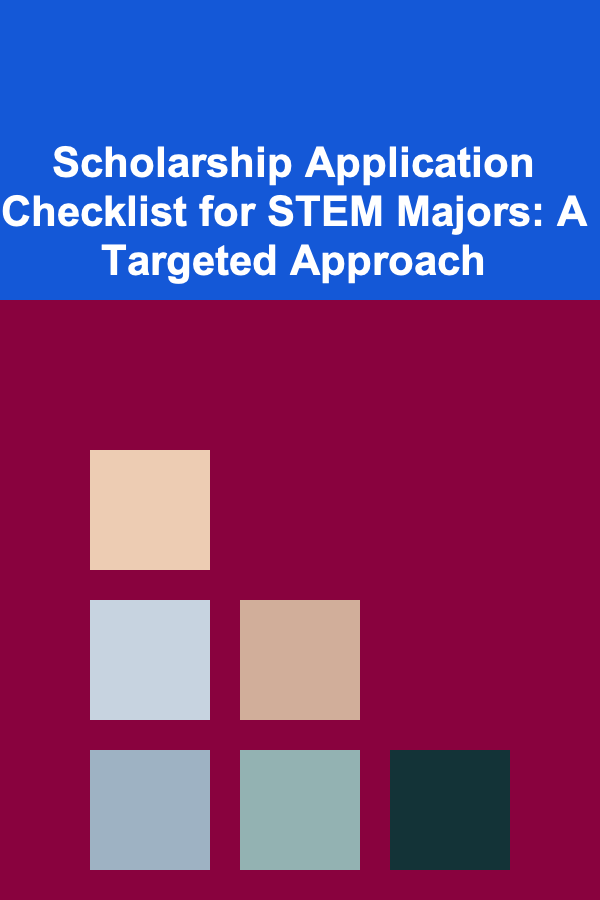
Scholarship Application Checklist for STEM Majors: A Targeted Approach
ebook include PDF & Audio bundle (Micro Guide)
$12.99$11.99
Limited Time Offer! Order within the next:

Pursuing a degree in STEM (Science, Technology, Engineering, and Mathematics) can be incredibly rewarding, but it often comes with a high financial cost. Fortunately, many organizations offer scholarships specifically designed for STEM majors, which can help reduce the financial burden of higher education. To maximize your chances of securing a scholarship, it's essential to approach the application process strategically. In this article, we provide a detailed checklist to guide you through the application process, ensuring that you leave no stone unturned in your quest for financial support.
Research Available Scholarships
Before you can begin your scholarship application, it's important to identify the scholarships that align with your field of study, personal background, and career goals. Scholarships for STEM majors can be offered by a wide range of organizations, including universities, private foundations, government bodies, and professional associations.
Key Steps:
- University and Department Scholarships: Many universities offer merit-based or need-based scholarships specifically for STEM students. Check with your department or financial aid office to see what options are available.
- Private Organizations and Foundations: Numerous non-profit organizations, such as the American Association of University Women (AAUW), offer STEM scholarships for underrepresented groups in these fields.
- Government Scholarships: Government programs, such as the National Science Foundation's Graduate Research Fellowship Program (NSF GRFP) or the SMART Scholarship for Service program, offer significant funding for STEM students at various levels.
- Industry-Specific Scholarships: Some companies or industries, like tech, engineering, or pharmaceuticals, offer scholarships to students pursuing degrees related to their business needs.
Evaluate Eligibility Requirements
Once you've compiled a list of potential scholarships, the next step is to carefully evaluate the eligibility criteria. Each scholarship has its own set of requirements, and ensuring you meet these is crucial to a successful application.
Key Considerations:
- Academic Performance: Many scholarships require a certain GPA or standardized test scores, such as the SAT or GRE. Check if there are minimum grade point averages required and assess whether your academic background aligns with the scholarship's criteria.
- Field of Study: Some scholarships are restricted to students pursuing a specific field within STEM, such as physics, biology, computer science, or engineering. Make sure the scholarship matches your area of focus.
- Demographics: Scholarships may be targeted toward specific groups, such as women, minorities, first-generation college students, or veterans. Read through the demographic requirements to ensure you fit the intended target audience.
- Citizenship and Residency: Certain scholarships are only available to U.S. citizens, legal residents, or international students. Verify the citizenship or residency requirements before applying.
Prepare Your Academic Transcripts
One of the most important components of your scholarship application is your academic transcript. A strong academic record is often a key factor in scholarship selection, particularly for merit-based awards.
Key Steps:
- Request Transcripts Early: Obtain your official transcripts from your high school or college. Ensure that they are up-to-date and reflect your most recent academic achievements.
- Grade Point Average (GPA): Many scholarships will consider your GPA when making their decisions. If your GPA is strong, emphasize it in your application, especially for academic-based scholarships.
- Include Relevant Coursework: If you are pursuing a STEM degree, highlighting advanced math or science courses that you've completed can be particularly beneficial. Some scholarships focus on specific STEM subjects, so make sure to showcase your relevant coursework.
Write a Strong Personal Statement
A personal statement or essay is a crucial part of many scholarship applications, especially for highly competitive STEM scholarships. This is your chance to tell your story, explain your passion for STEM, and demonstrate why you deserve the scholarship.
Key Tips for Writing:
- Be Personal and Authentic: Share your personal journey, including how you became interested in STEM, any challenges you've overcome, and what motivates you to pursue this field.
- Focus on Your Career Goals: Outline your long-term goals in STEM and explain how the scholarship will help you achieve them. Be specific about the impact you hope to make in the field.
- Showcase Your Achievements: Highlight your academic accomplishments, research projects, internships, or any relevant extracurricular activities. If you've participated in science fairs, engineering competitions, or other STEM-related events, be sure to mention them.
- Tailor Your Statement: Customize your essay for each scholarship application. Different scholarships may value different aspects of your background, so ensure your statement addresses the unique criteria of each scholarship.
Secure Letters of Recommendation
Most STEM scholarships require at least one or two letters of recommendation. These letters should come from individuals who can speak to your academic abilities, character, and potential in your chosen field.
Key Steps:
- Choose Reputable Recommenders: Ideally, your recommenders should be professors, mentors, or supervisors who are familiar with your academic performance or professional work. Select individuals who know you well and can speak to your strengths and potential in STEM.
- Ask Early: Give your recommenders plenty of time to write strong letters. Approach them at least a month in advance and provide them with any necessary background information or specific points you'd like them to highlight.
- Provide Supporting Materials: Share your academic transcript, resume, and personal statement with your recommenders. This will help them write more detailed and personalized letters.
- Be Specific: When requesting a letter, be clear about the scholarship's requirements and what qualities the letter should emphasize (e.g., leadership, research experience, or community involvement).
Update Your Resume
A polished, professional resume is an essential part of any scholarship application. Your resume should highlight your academic achievements, extracurricular activities, work experience, and skills related to your STEM field.
Key Elements to Include:
- Academic Achievements: List your GPA, any honors or awards, and relevant coursework. Highlight your academic successes, particularly in STEM subjects.
- Research and Internships: If you've worked on any research projects or completed internships in your STEM field, be sure to emphasize these experiences. Include details on your contributions and any outcomes from these experiences.
- Extracurricular Activities: Participation in STEM clubs, volunteer work, or leadership roles can make your application stand out. Show how you've contributed to the STEM community outside of the classroom.
- Technical Skills: Many STEM fields require specific technical skills, such as proficiency in programming languages, lab techniques, or engineering tools. List any relevant skills that set you apart from other applicants.
Prepare for Interviews (If Applicable)
Some scholarship programs require an interview as part of the selection process. If you're selected for an interview, it's important to prepare thoroughly.
Key Steps:
- Review Your Application: Be familiar with everything you've submitted, including your personal statement, resume, and any other supporting documents. The interviewers may ask you to elaborate on aspects of your application.
- Practice Common Questions: Prepare for common scholarship interview questions, such as "Why are you pursuing a STEM degree?" and "How do you plan to contribute to the field of STEM?" Practice your answers out loud to build confidence.
- Be Professional: Dress appropriately for the interview, whether it's in person or virtual. Maintain good posture, make eye contact, and be enthusiastic about your passion for STEM.
Meet All Deadlines
Scholarship applications have strict deadlines, and missing them can disqualify you from consideration. It's crucial to stay organized and ensure that all components of your application are submitted on time.
Key Tips:
- Create a Timeline: Develop a timeline with all scholarship deadlines, as well as internal deadlines for preparing your materials. For example, set your own deadline for completing your personal statement and gathering letters of recommendation a few days before the actual deadline.
- Track Your Submissions: Keep a record of the scholarships you've applied for and confirm that all documents have been received. Some scholarships may require additional steps, such as sending transcripts directly from your school.
Proofread Your Application
Before submitting any part of your scholarship application, make sure to carefully proofread it. Errors in grammar, spelling, or formatting can hurt your chances of being selected.
Key Steps:
- Check for Clarity: Ensure that your personal statement and other written materials are clear, concise, and free from jargon. Your writing should be easy to read and communicate your points effectively.
- Peer Review: Ask a trusted friend, teacher, or mentor to review your application before you submit it. They may catch mistakes that you missed and provide helpful feedback.
- Formatting: Ensure that your application materials are well-organized and follow the scholarship's guidelines. This includes formatting your essay, resume, and any other documents according to the specified requirements.
Follow Up
After submitting your application, follow up with the scholarship organization to confirm that all materials have been received and to inquire about the timeline for selecting recipients.
Key Steps:
- Send a Thank-You Note: If you've interacted with scholarship organizers or recommenders, sending a thank-you note is a polite gesture that helps build professional relationships.
- Monitor Your Email: Many scholarships notify winners via email, so make sure you regularly check your inbox for updates.
Conclusion
Applying for scholarships as a STEM major requires careful planning and attention to detail. By following this comprehensive checklist, you can ensure that your application stands out and gives you the best chance of securing the financial support you need to pursue your STEM degree. Whether you're a first-year student or nearing the end of your program, these strategies will help you navigate the competitive scholarship landscape and take your education to the next level.
Reading More From Our Other Websites
- [Personal Finance Management 101] How to Pay Off Debt Faster Without Stress
- [Home Lighting 101] How to Strategically Place Landscape Lighting to Illuminate Dark Areas Around Your Home
- [Horseback Riding Tip 101] Top 10 Riding Horse Breeds for Every Skill Level
- [Home Security 101] How to Choose and Install a Security Camera for Optimal Coverage and Peace of Mind
- [Ziplining Tip 101] From Beginner to Thrill-Seeker: My First Zipline Experience Reviewed
- [Home Pet Care 101] How to Provide Enrichment for Indoor Reptiles
- [Organization Tip 101] What Items Should You Keep in a Home Emergency Kit?
- [Organization Tip 101] How to Use Drawer Dividers for Small Craft Items
- [Home Cleaning 101] How to Clean Baseboards Like a Pro
- [Home Staging 101] How to Make Small Rooms Look Bigger Through Staging

How to Maintain Your Home's Exterior for Better Curb Appeal
Read More
How to Use Cash Envelopes to Stick to Your Home Budget
Read More
Monetize Your Deep Learning Skills: Start Earning Today
Read More
Why Organizing Craft Supplies Boosts Creativity and Fun
Read More
How To Use Technology to Aid Time Management
Read More
How to Develop Large Format Film: A Comprehensive Guide
Read MoreOther Products

How to Maintain Your Home's Exterior for Better Curb Appeal
Read More
How to Use Cash Envelopes to Stick to Your Home Budget
Read More
Monetize Your Deep Learning Skills: Start Earning Today
Read More
Why Organizing Craft Supplies Boosts Creativity and Fun
Read More
How To Use Technology to Aid Time Management
Read More